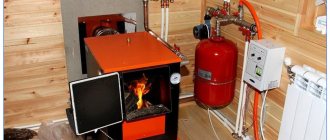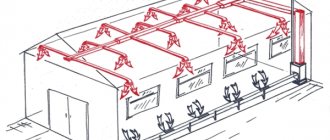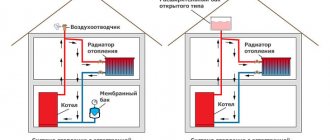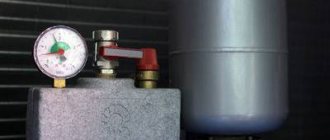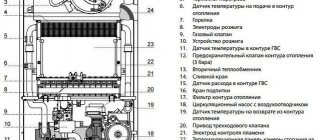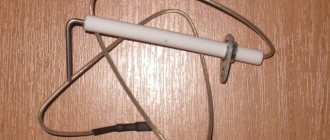Work to ensure the proper functioning of heating equipment does not end with its installation. Maintenance requires the owner to have a certain level of knowledge and constant monitoring of the condition of the system. It is important to understand why the pressure in a gas boiler drops or rises, which is why the equipment operates with fluctuations.
The article we presented describes in detail all the reasons for pressure instability in the coolant and hot water preparation system. We'll show you how to troubleshoot and keep your readings within normal range. Our recommendations will help you cope with emerging breakdowns and prevent operational failures.
What is the normal pressure in a gas boiler?
The normal pressure in the boiler makes it possible to reduce heat loss to a minimum, and for the coolant to remain at the same temperature as exists in the boiler. Specifically answer the question: “What pressure should be in a gas boiler?” it is forbidden.
This value is influenced by the following criteria:
- heating circuit length;
- number of batteries;
- battery power;
- how many floors are there in the building?
Therefore, this value is calculated by creating a project and taking into account the characteristics of the equipment and materials used in the system. For example, for a private two-story cottage, up to 3 atm will be sufficient. pressure forces. To control the pressure of the heat resource flow, you need to install a pressure gauge.
The design and capabilities of the coil where the resource is heated directly affect the optimal pressure. Modern gas boilers are equipped with high-quality heat exchangers that can withstand up to 3 atmospheres. For units operating on solid fuel, it is recommended to use an indicator of 2 atm., not higher.
The values indicated in the data sheet indicate the maximum threshold that the boilers are capable of, and it is not advisable to “force” them to operate in this mode. This is due to the fact that when heated, the pressure inside the system increases. The average value between the lower and upper thresholds can ensure the full functioning of the boiler and radiators.
To find out the optimal operating pressure, it is necessary to take into account the parameters of the manufacturer of the boiler and other heating devices. Usually their indicator varies between 0.5 - 1.5 atmospheres. If the value in the autonomous heating system is within these limits, it will be sufficient for normal operation.
In addition, during the heating process of the resource, the pressure in the gas boiler may fluctuate slightly, and in settings with a lower value level this will not greatly affect the operation of other parts of the line. Operation in high pressure mode involves additional loads and requires the installation of an expansion tank and a safety valve.
Diaphragm expansion tank - calculation principles
Often the reason why there is a loss of pressure in the heating system is the wrong choice of a double-circuit heating boiler
That is, the calculation takes into account the area of the premises in which heating will be carried out. This parameter affects the choice of area of heating radiators - and they use a relatively small amount of coolant
However, sometimes after the calculation, radiators are replaced with pipes, which use a significantly larger amount of water (and this fact is not taken into account). Accordingly, it is precisely this error in the calculation that leads to an insufficient level of pressure in the system.
Expansion tanks come in a variety of sizes
For the normal functioning of a double-circuit system with 120 liters of coolant, an expansion tank with a volume of 6-8 liters is sufficient. However, this amount is calculated for a system that uses radiators. When using pipes instead of radiators, there is more water in the system. Accordingly, it expands more strongly, thereby filling the expansion tank completely. This situation leads to an emergency release of excess liquid using a special valve. This causes the system to shut down. The water gradually cools down and its volume decreases. And it turns out that there is not enough fluid in the system to maintain the pressure at a normal level.
In order to avoid such an unpleasant situation (hardly anyone will be happy about the breakdown of the heating system in the cold season), it is necessary to carefully calculate the volume of the required expansion tank. In closed systems supplemented by a circulation pump, the most rational is to use a membrane expansion tank, which functions as an element such as a heating pressure regulator.
Table for determining the maximum volume of liquid that the tank can hold
Of course, it is quite difficult to calculate the exact amount of water in the pipes of the heating system. However, an approximate figure can be obtained by multiplying the boiler power by 15. That is, if a boiler with a capacity of 17 kW is installed in the system, then the approximate volume of coolant in the system will be 255 liters. This indicator is useful for calculating the appropriate volume of the expansion tank.
The volume of the expansion tank can be found using the formula (V*E)/D. In this case, V is an indicator of the volume of coolant in the system, E is the expansion coefficient of the coolant, and D is the efficiency level of the tank.
D is calculated this way:
D = (Pmax-Ps)/(Pmax +1).
Here Pmax is the maximum pressure level permissible during system operation. In most cases - 2.5 bar. But Ps is the tank charging pressure coefficient, usually 0.5 bar. Accordingly, substituting all the values, we get: D = (2.5-0.5)/(2.5 +1)=0.57. Next, taking into account that we have a 17 kW boiler, we calculate the most suitable tank volume - (255*0.0359)/0.57=16.06 liters.
You should definitely pay attention to the technical documentation of the boiler. In particular, a 17 kW boiler has a built-in expansion tank with a volume of 6.5 l
Thus, for the correct functioning of the system and to prevent such cases as pressure drop in the heating system, it is necessary to supplement it with an auxiliary tank with a volume of 10 liters. Such a pressure regulator in the heating system can normalize it.
What is the pressure in the expansion tank of the heating system
One of the questions that our readers often ask. Apparently, it occurs either when problems arise during the operation of the heating system, or when it is necessary to carry out maintenance on a gas boiler that has a built-in expansion tank.
Although the expansion tank is not the most important element of the heating system, it is nevertheless necessary to understand why it is needed and what role the pressure plays in the expansion tank of a closed-type heating system. We will talk specifically about closed-type devices that are used in heating systems with a circulation pump.
The main purpose is to compensate for the thermal expansion of water. According to the laws of nature, when heated, a liquid tends to increase its volume. Normal circulation in a closed heating system can only be ensured if the system is completely filled with coolant (water or antifreeze) and that is why, when the heating process is started, excess coolant needs to be accumulated somewhere. It simply cannot be otherwise - the liquid is incompressible.
If it happens that the liquid has nowhere to go, there will be a place in the system through which the excess will come out. In closed-type heating systems, special safety valves must be installed for such a case - but this is a topic for a separate article.
What is nominal pressure and its parameters
The nominal pressure for a gas boiler is the highest permissible pressure in the system in question (gas, water), at which the device operates properly for a guaranteed period. For each specific boiler, the instructions provide its own indicators of this value.
Now let’s figure out what the working pressure (Pa) of water means - it indicates the value of the maximum permissible indicator at the outlet of the device, subject to normal operation. Before the system is filled with liquid, it is equal to atmospheric pressure, that is, 1 bar.
Reasons for deviation from the norm
The heating system must operate uninterruptedly during the heating season, which is almost six months. At this time, each owner wants heat to be supplied in the required quantity, that is, the pressure in the heating boiler must be constantly within normal limits.
Practice shows that not everything is always as smooth as you want it to be. Under the influence of certain factors, malfunctions in the operation of the heating system or equipment occur. What affects the efficiency of an autonomous heating structure?
First boiler startup and adaptation period
To be able to provide warranty service for your unit, the first start-up must be carried out by a service organization. Starting the boiler is possible only after completion of construction and repair work in the room where the boiler is located.
A trial run of a double-circuit boiler consists of the following activities:
- fulfillment of installation requirements;
- checking the tightness of all components and connections;
- starting the unit, setting parameters;
- registration for warranty service.
Initially, using the make-up tap, which is usually located at the bottom of the device, the system is slowly filled with water. In this case, you need to monitor the pressure gauge readings. the pressure must be within the limits specified in the instructions for the specific device. As soon as the pressure gauge shows a sufficient value, the feed tap must be closed.
Reasons for the drop in pressure
A decrease in performance in most cases occurs due to the fact that a leak has appeared in the areas where the pipeline connects to the device. A coolant leak can be temporarily eliminated using a booster valve.
If there is no such node, then a resource is added to the main line either from a well or from a water supply system, focusing on the level of reduction in water pressure in the gas boiler.
Such actions will only solve the problem for a certain period, but the pressure will not be fully restored.
You can get rid of the problem as follows:
- find the location of the leak;
- turn off the heat source for a while;
- shut off the water supply;
- drain the liquid from the section of the pipeline where a leak is detected;
- repair the part;
- pump water into the system and start the boiler.
How to detect a leak? A wet spot or water at the joints speaks volumes about this. If there are no visible signs, try raising the pressure to 3 atm. and start the circulation pump.
In cases where this does not identify the area with a coolant leak, completely drain the water and pump in air. A characteristic hiss will tell you where the leak is located. To convince yourself, take soapy water and apply it to the air outlet, now you will definitely see where the problem is.
Other reasons for the drop in pressure:
- failure of the heating device or its wear;
- formation of scale and deposits on parts in the heat exchanger, on pipes;
- water hammer, as a result of which the heat exchanger broke down;
- if a hydraulic accumulator is installed, the cause may be its depressurization;
- the pressure regulator has failed;
- decrease in temperature.
When there is severe frost or the system is turned off for some time, the walls of the house cool down. As a result, the coolant also cools down, and the pressure indicator decreases accordingly. Therefore, the coolant should not be allowed to freeze. It is necessary to maintain at least a minimum value of 0.9 - 1.0 atm. If the heating system is used from time to time in cold weather, it is necessary to drain the water from the main line each time.
Finding a damaged node and troubleshooting
To identify a leak in a closed heating circuit, it is necessary to inspect the detachable and permanent elements of the pipeline and radiators, control water taps, threaded connections, welding and soldering points, and the Mayevsky tap for integrity.
If you notice an accumulation of water under radiators, pipes, etc., determine the cause of its appearance. Puddles can form under threaded connectors (with sudden temperature changes, this type of connection spontaneously unwinds), poor-quality soldered or welded seam, or parts with microcracks. To stop the leak at the threaded connection, it is enough to pull this unit. In rare cases, the sealing insert needs to be replaced. To inspect a part or area with a defect, you should partially or completely drain the water from the heat supply line. There is a direct relationship between the leakage of the make-up tap and the pressure in the central water supply. When water pressure increases or decreases, the pressure in the boiler also changes, although the boiler feed valve is in the closed position. Typically the pressure in the central pipeline is 0.5 - 3 bar. If you do not find a leak in the heating circuit, monitor the change in pressure in the boiler and the central pipeline. If a direct relationship is identified, replace the feed tap (in non-separable models) or change the sealing collar (in models with a removable rod).
Sometimes, for some reason (outdated model, lack of opportunity to purchase, etc.), it is not possible to purchase a new valve, then you can connect the pipes: cold water supply to the boiler and return from the heating circuit, using conventional shut-off valves.
Schematic placement of the heating system feed tap.
In this case, the standard feed tap must be in the closed position and not let water through. If it is very worn, it must be dismantled, the stem raised, the internal holes filled with silicone and the valve set to the closed position. Mount the tap in its original position and no longer use it for its intended purpose. But these manipulations should be performed only in extreme cases.
The pressure in a closed heating system also changes due to a large amount of air not removed from the system. Although modern boilers are equipped with automatic air vents, they can malfunction due to scale build-up. Carefully inspect the air vent for any foreign deposits. It is usually located near the circulation pump.
Air vent for wall-mounted gas boiler.
If there is scale, clean the air vent. Using a flathead screwdriver, lift the cap and turn on the pump in circulation mode. If such a function is not available in your boiler model, start the boiler in heating mode. All the air will come out of the pipes and radiators. Also, air can be removed through Mayevsky taps, which should be equipped with all heating radiators at the top point.
Mayevsky tap at the top point of the heating radiator.
Violation of the integrity of the membrane, spool, as well as a decrease in pressure in the air cavity of the make-up tank leads to a dynamic change in pressure. Before examining the condition of the expansion tank, determine its installation location. To check the tightness of the membrane and the mechanism for pumping air, unscrew the cap from the spool valve.
Signs of a leak in the expansion tank membrane.
The presence of water inside the valve indicates damage to the membrane. In this case, since the tank is sealed, it becomes unsuitable for repair and must be replaced with a similar one. The appearance of bubbles from the working hole of the distributor wetted with liquid indicates wear of the spool sealing ring. Tighten the valve core or replace it.
The listed measures have been tested and are effective ways to restore stable coolant pressure in a closed heating circuit.
When renovating a room or installing a heating system in it, the question arises of how to choose an electric heated floor and in what cases it is used.
When the pressure increases
The reasons for the increase in operating pressure in a gas boiler are:
- malfunction of the automatic control unit - poor quality of filling the line with coolant;
- a decrease in the circulation rate of the coolant contributes to overheating of the resource in the pipes and an increase in pressure;
- formation of air jams in the system;
- the cleaning filter is full or any part of the heating structure is clogged with dirt;
- the valve may be closed;
- installation was performed incorrectly.
Why the pressure in a gas boiler increases cannot be simply determined. First of all, it is necessary to identify the emerging factors, analyze them and draw conclusions.
It is possible to solve the problem of an increase in water pressure above the norm by releasing excess heat resources, forcibly turning off the pumping device, and, if necessary, pumping up the liquid until the value returns to normal.
If during the repeated process the range of jumps becomes smaller, that is, the pressure in the working boiler gradually approaches the optimal value, it means that there were air plugs in the system.
The proposed method of troubleshooting may result in nothing: this means that where the line is clogged with dirt deposits, which prevents the boiler from functioning fully. To solve the problem, it is necessary to clean the filter, and, if necessary, the heat exchanger. The cleaning procedure can be either mechanical or hydraulic. The main thing is not to cause damage to the internal surfaces and pipes connecting the boiler to the pipeline.
How to install
Installing an expansion tank is not particularly difficult, that is, it is not at all necessary to have any skills or craftsmanship. The installation process will also not take much time. Installation is easy and quick. But, nevertheless, you should follow the instructions and carefully follow each step.
- First you should turn off the heating system, that is, turn off the boiler. Then you should take the tank and use a regular car pump to inflate it with air. To do this, remove the special plug located on the top of the device. This is the first stage of preparatory work.
- Then you need to drain all the water from the heating lines. To do this, you need to open the tap and wait until all the liquid is released from the pipes and radiators.
- Now you can install the tank. In general, the tank can be mounted anywhere, but it is advisable to install it near the boiler on the pipe through which water enters the boiler. For installation, special tees are used. It is also recommended to use a shut-off type valve. It is needed in order to, if necessary, block the coolant inlet into the tank.
- Now open the tap and fill the system with coolant. Then turn on the boiler.
That's all! If the tank is installed in accordance with all instructions, it will function correctly.
When the temperature of the coolant rises, excess liquid will flow into the tank, and when the temperature returns to normal, the liquid will return to the pipes.
If the tank is not selected correctly, then its capacity may not be enough for the amount of coolant that expands when heated. If this happens, the pressure will increase, resulting in liquid being discharged from the system automatically and the boiler will stop operating. After turning off the boiler, it can be turned on again. If there are no residents in the house for a long time, and there is no one to turn on the system, then due to frost, it will simply stop functioning. The boiler will have to be replaced.
Based on the foregoing, we can conclude that the expansion tank is one of the most important elements of any heating. It plays the role of a kind of fuse, where part of the coolant will flow in the event of its thermal expansion. If the system does not have such a tank, then as the temperature of the liquid rises, constant emergency shutdowns will occur.
So, in order for all heating to work uninterruptedly and bring warmth and comfort to the house, the tank must be selected correctly, because it is the correct expansion tank that contributes to the correct operation of the entire heating system.
How to get rid of pressure surges in the heating system
Complete information about the activity of the entire pipeline can be obtained by installing pressure gauges in several areas. By examining the value indicators on the devices, the owner himself can detect a place where the heat transfer fluctuates, is not stable, and therefore the likelihood of a malfunction in this area.
The entire heating system will function efficiently and efficiently if you install:
- an expansion tank with a membrane, thanks to which, when pressure increases above two atmospheres, its increase is compensated;
- protection systems: pressure gauge, automatic air venting unit, safety valve. The valve opens at a certain pressure value, which leads to the release of excess pressure.
Installing the above elements ensures that the pipeline will not rupture and the heat exchanger of the gas boiler will not be damaged.
When there are jumps of this magnitude, look for the bleed and discharge valves located near the boiler. If the water pressure in the gas boiler is low, open the discharge valve, add water to the required volume, and close the tap. If you need to reduce the pressure, open the bleed valve and drain water into a previously placed container until the value reaches the desired level
If there is no expansion tank
The expansion tank for a home heating network is the second most important element (after the boiler). Water, when temperature changes, changes in volume. The volume inside the circuit is always constant, so an expansion tank is additionally connected to the circuit, where excess coolant can be diverted, i.e. acts as a compensator. Consequently, the RB is a safety device that prevents emergency situations - increased pressure, depressurization of pipes, etc.
The use of boiler equipment without an expansion tank is highly not recommended.
For stable operation, the pressure of the RB must correspond to the system volume, because when replacing radiators with pipes, the volume of coolant must be increased. At the same time, a too large RB will not maintain the operating pressure in the circuit.
The standard is an expansion tank designed for 120 liters of coolant in the circuit (typical two-room apartment). If the tank is too small, then the water will be discharged when heating and expanding the volume through a safety valve. When the boiler is turned off, when the liquid temperature decreases, starting the boiler will be impossible, because its volume, and, consequently, the pressure will be insufficient. In such cases, additional network feeding is necessary.
https://youtube.com/watch?v=tgwLKEVRgYk%3F
Briefly about the main thing
Normal pressure in the heating system contributes to comfortable living. Ensuring that the pressure gauge needle shows the normal pressure value in the gas boiler is the responsibility of every owner of a house with a heating boiler.
Of course, how much pressure should be in a gas boiler is different for specific systems, since the type of system, equipment features, number of floors of the room - all this affects the value of the normal operating pressure in the heating design.
Preventing the formation of air jams
Preventative measures against the occurrence of air locks are as follows:
Pay attention to the correct installation of pipes and connections of heating devices
Many problems are caused precisely by mistakes made at this initial stage. To prevent air locks, proper commissioning of the equipment is necessary, before which it is important to first check all components and connections. Before putting devices into operation, check them for operability. Using a compressor, you need to apply a pressure level that is ¼ higher than its normal operating value. If it does not weaken within 30 minutes, then everything is in order and the system is ready for operation.
If the pressure drops sharply, then leaks are possible, which should be promptly identified and repaired before starting operation.
Watch a video on how to restore normal boiler pressure

